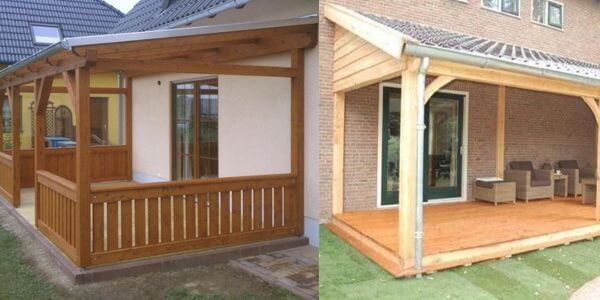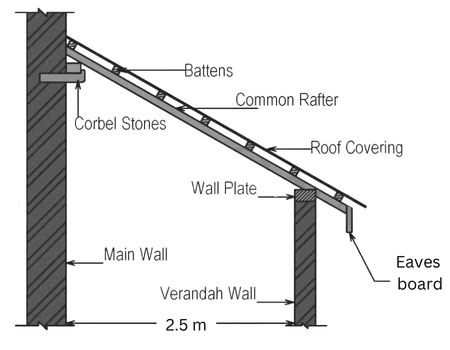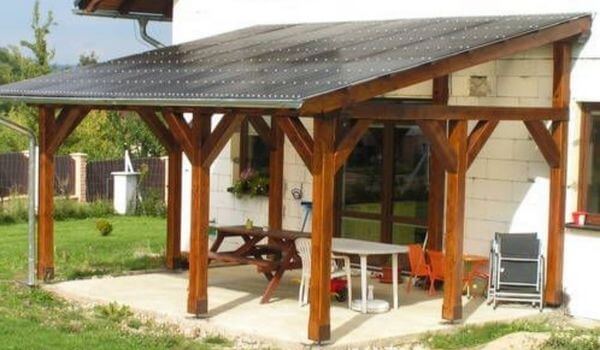Table of Contents
What is a lean to Roof?
A lean to roof is a type of roof having a slope of only one side whose upper edge is attached to an existing structure or a wall.
This is the most basic and typical style of the sloping roof, as well as the least expensive choice for covering a structure.
The lean-to roof is mostly used to build sheds, carports, verandahs, straightforward additions, etc.
This type of roof is incredibly simple and low-cost to build. Snow and water can easily drain off the roof due to its slope,
which lowers the additional expense of waterproofing the roof. High rainfall and snowfall areas are ideal for lean-to roofs.
The simplicity of building is a lean to roof’s main benefit. These roofs require less labor or material because they just have one slope.
What you need to know about lean to roofs if you’re thinking of constructing an addition to your home, garage, or outbuilding.
The simplest kind of pitched roof is a lean-to roof. The sloping roof is another name for the pitched roof. It is the most typical type of roof and is typically thought of as the least expensive option for roofing a structure.
Lean to roofs, also known as Skillion roofs, are a type of shed roof. A shed roof can be compared to one flat roof with a steep slope.
To put it simply, the shed roof has a single slope, whose steepness might change depending on the design.

Prior to now, this design was typically reserved for sheds, but it is becoming a popular choice for residential homes.
One of the neatest ways to attach an extension to any existing building is with a lean to roof design.
Additionally, when creating a carport or providing shade and screening to a porch, they are a trendy option.
Lean to roof Design
Lean to roofs are shed roofs with a sloped side that butts up against another building. Lean to-roofs are used by contractors to expand homes or outbuildings. Depending on their purpose, lean to roofs might have all four sides closed or left open.
Lean to roof prevents water or snow from building up on the roof because of their steep pitch, but they need gutters for proper drainage.
A lean to roof is a standalone building. One side’s wall is higher than the other side’s wall.
The upper portion of the common rafters of this lean to roof is situated on a wooden wall plate and is additionally supported by a corbel.
Stone, brick, or iron are used to construct this corbel. Common rafters’ lower ends are notched, and they are fastened with nails to a wooden post plate that is attached to the tops of posts on the verandah wall.
The rafters and post plate are also joined together with the help of iron knee straps and bolts. Common rafters are leaning on a wall at a 30° angle.

This roof’s length allows for a maximum span of 2.5 meters. One side roof is another name for the side roof, which is used to cover a building’s verandah.
A wall or other roof is used as support for this lean-to roof. This roof is mostly used to build sheds, easy additions, carports, verandas, etc.
When a storage facility needs more room than the lean-to roof built using an existing wall can provide, lean to roofs are used.
This could happen during the initial building process or even after the execution has been completed and a few years have passed.
The roof coverings of this construction could be made of pre-coated sheets, AC sheets, or Mangalore tiles in addition to their practical use for the roof.
This roof is insufficient for a long span if the width is greater than the required minimum clearance of 2.0 to 2.5 m at the eaves level.
Suitable Materials for Lean to roof
The following are the best materials for lean-to roofs.
- Clay Roof Tiles
- Concrete Tiles
- Metal Sheets
- Glass Roofing
- Polycarbonate Sheet
- Asphalt Shingles
Clay Roof tiles
Clay roof tiles are available in various colors, including brown, white, orange, and others. Compared to other types of roof tiles, clay roof tiles are more resilient.
The constructions are covered with clay tiles. Concrete was less widely utilized in ancient times; instead, people prepared their roofs with the use of clay or mud and mixed cow dung in place of cement.
Concrete Tiles
The structures are covered with concrete tiles. In comparison to other types of tiles, concrete tiles are quite inexpensive. It is strong and long-lasting.
Metal Sheets
A lean-to roof is constructed using a metal roof as support. Metal roofing is adaptable in terms of shape and design, needs little upkeep, and comes in a variety of colors.
Glass Roofing
Lean-to roofs are constructed with glass roofing, which may be more expensive than other forms. One of the best roofing materials is glass since it lets sunshine into the building.
This improves the structure’s overall aesthetic appeal. The glass roof, however, is challenging to move and there’s a danger it could break.
Polycarbonate Sheet
Polycarbonate sheets are incredibly light and simple to move from one location to another. The impact resistance of polycarbonate is good. Due to its great degree of flexibility, polycarbonate may be molded into a variety of shapes to suit the needs of the structure.

Asphalt Shingles
One of the first roofing materials utilized in the building was asphalt shingles. The asphalt shingles are effectively fire-resistant.
Advantages of Lean to roof
Affordable
Due to their simplicity, these are also cost-effective. It features a fairly straightforward roofing design with only one slope, which makes it simpler and quicker for the contractors and eventually lowers expenses.
Prevents Snow or Water Pooling
Water that collects on a roof can lead to leaks and other problems. If you need to improve water and snow drainage, this roofing design is perfect.
Clean, contemporary, and minimalist,
A lean-to roof is ideal for a home with a modern design since it is simple, modern, and minimalist. The shed blends in well with the overall design since it gives the house a very modern, minimalistic, and clean appearance.
Allows Skylight or solar panel installation
Skylights and solar panels can be installed with this roof type because it leaves a lot of room on one side of your house for these additions.
Any material may be used
The roofing material for your lean-to roof can be matched to the existing building materials.
Water Harvesting
Rainwater can be conveniently harvested in the case of lean-to roofs.
Disadvantages of lean to roof
Not Suitable for Big Houses
Lean-to roofs are inappropriate for huge homes, which is why they should not be used for such structures.
Less Flexible
Lean-to roofs are renowned for giving homes a contemporary look; as a result, not all homes go well with them. A shed roof, for instance, could not fit in with the traditional-style home you are creating.
Drainage issues When it rains heavily
there is a lot of strain on the gutters because the shed roof just has one slope. In essence, you can’t count on them to handle higher amounts of water efficiently.
Little or No Attic Space
There is little to no attic space in most homes with lean-to-roof designs since the ceiling slopes in the same direction as the roof.
Susceptibility to High Winds
High winds can more easily pull a lean-to roof off a house than a more sturdy one, making it more vulnerable to high winds.
So, if you reside in a region where there is a greater chance of hurricanes or higher winds, this roofing design might not be the ideal choice.
Final Words
The benefits and drawbacks of each roof type can be compared to help you choose one by reducing your options.
We sincerely hope that this information has improved your understanding of the lean-to roof design.
These provide a straightforward, contemporary style on a budget and are simple to build, but you need to plan for the possible downsides to ensure the benefits outweigh the disadvantages.
What is meant by lean to roof?
A single-sloped roof attached to an existing structure is known as a lean to roof. Homeowners most frequently use lean to roofs to enlarge their homes and outbuildings.
What is the best material for a lean to roof?
The best materials for lean-to roofs include
Polycarbonate sheets
Cement tiles
Glass
PVC sheets
Asphalt Sheets
Galvanized steel sheets
SyntheticTiles
For a lean-to roof, is planning permission required?
While it is uncommon to require planning permission, if you want to switch out a glass roof for a solid roof, your local building control department will probably need to approve the change.
What is the required pitch for a lean to roof?
The minimum pitch for lean-to roofs is 1/4:12. This equals a quarter-inch raise for a 12-inch run. The only lean-to roof types that can employ this pitch are those with built-up or specialty synthetic roofs.
Also, Read
What is A Gable Roof?|5 Types of Gable Roof
What is a Parapet Wall? – Purpose & Uses | 10 Types of Parapet Wall
Parts of A Door, Door Jamb – A Complete Guide
8 Types of Stairs, Flight of Stairs
Standard Door Size|Standard Door Width| Standard Door Height| Standard Door Frame Size